
views
Capturing a Caterpillar

Wait for the right season to go looking for caterpillars. Caterpillars need specific weather and seasonal conditions before they can be found. You'll need to wait for warm weather and summer months before you can begin searching for your caterpillar. The month of June is the ideal time to begin your search, as caterpillars will just start to be active during this time. If you wait too long, caterpillars may already be in their pupa or butterfly stages of life. Searching too early in the year will make finding caterpillars difficult or impossible.
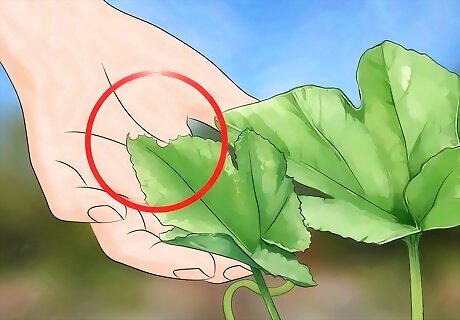
Go outside and start your search. Once you have a nice day in June with some good weather, you can get outdoors and start looking for a caterpillar. Many caterpillars will still be small this time of year, so search for them carefully to avoid missing them. Try looking in some of these locations to help you in your search: Look on any leaves or shrubs that you pass by. Seeing small holes or areas cut away from leaves can indicate that a caterpillar was recently eating it. Look carefully. Many caterpillars have natural camouflage and can be hard to spot.

Try looking for certain plants. Many caterpillars will have a certain type of plant that they prefer to eat. Because of this, it can sometimes be easier to find the plant before finding the caterpillar. Take a look at some of these plants that caterpillars prefer to help your search be successful: Milkweeds can attract monarch butterfly caterpillars. Spicebush swallowtails are known to prefer the spicebush plant. Zebra swallowtails enjoy being near the paw-paw plant. Dill, fennel and parsley can be a good places to find black swallowtail butterflies.
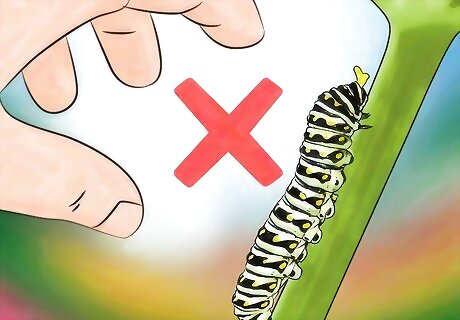
Avoid touching any caterpillar you find. Although it may be tempting to pick up a caterpillar with your hands, you should avoid doing so. Caterpillars are small, fragile insects that can easily be hurt if you pick them up. Some species of caterpillars may have hairs or secretions that can irritate your skin if you touch them. Always avoid touching any caterpillar you find to keep both you and the caterpillar safe.
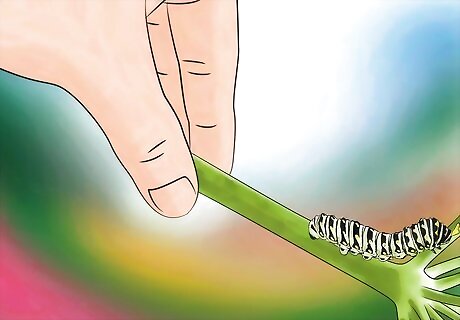
Take the entire leaf that you find your caterpillar on. Once you've found a caterpillar that you want to take home and care for, you can collect it by picking up or breaking off the entire leaf that you find it on. Taking the whole leaf will provide food for the caterpillar and will help prevent it from being harmed. Be gentle with your caterpillar. Many caterpillars will be small and easy to hurt. You can put the leaf and the caterpillar directly in a small bug cage if you have one ready. It's a good idea to take many of these leaves so that your caterpillar will have plenty of food to eat when it gets home. Keep an eye on your caterpillar. Make sure it doesn't fall or blow off of the leaf. Don't take too many caterpillars from one place. You should collect five caterpillars at most.

Identify your caterpillar. Depending on the species of the caterpillar you find, you will have to provide specific methods of care for it. It's always a good idea to bring a field guide out with you when searching for caterpillars to allow for quick identification. You can also try looking up the type of caterpillar after you've captured it to learn more about it. Always make sure you are certain which type of caterpillar you've found before giving it a new home. Improper care of a caterpillar can result in it being harmed or dying. You can use certain physical characteristics such as length, color and shape to learn the caterpillar's species. The type of plant you find your caterpillar on can be a helpful clue when identifying which species it belongs to. Some caterpillars may turn into butterflies. Other caterpillars could turn into moths. Moths and butterflies will each have their own unique care requirements.
Caring for Your Caterpillar
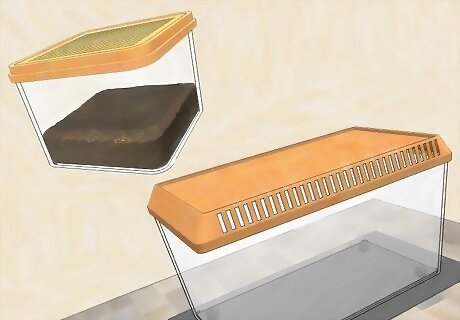
Create a small enclosure for your caterpillar. Your caterpillar will need a safe space to live and grow in. The key elements of a good caterpillar house are air, water and food. You'll need to provide everything the caterpillar would normally have in the wild to help it grow up into a butterfly. Make sure your caterpillar cage has some of these features: The cage should be at least three times the size of your caterpillar. There will need to be proper ventilation in the cage to allow air to enter and exit. The cage should have room for some sticks, leaves and small branches. Make sure the cage doesn't have anywhere your caterpillar could get stuck or cut on. You can add in optional strips of paper to collect any messes the caterpillar might make. A simple plastic jar with holes punched in the lid will work just fine as a caterpillar home.
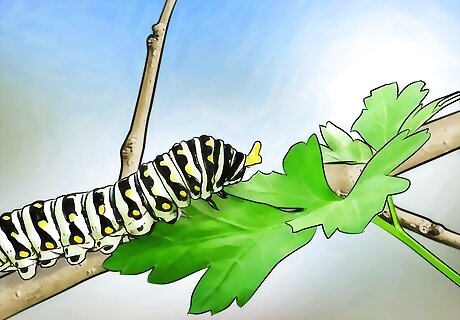
Provide food for your caterpillar. Like every other creature, caterpillars will have to eat in order to grow and survive. It's important that you provide fresh food everyday for your caterpillar. Caterpillars are oftentimes picky eaters and will need to eat very specific leaves. Make sure you are following these guidelines when feeding your caterpillar: Feed them the exact same type of leaf that you first found them on. Provide fresh leaves everyday. Leaves have to be soft, not crunchy. Remove old leaves from their home.
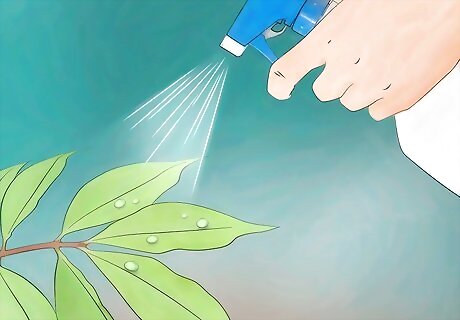
Add water for your caterpillar to drink. You'll need to provide clean water for your caterpillar to drink while it grows up in your cage. Although caterpillars won't need much water, it's important that they do have some available. Keep some of these tips in mind when providing water for your caterpillar. You can simply wash the caterpillar's leaves in water and put them in the cage. The droplets of water that are leftover will be enough to keep them hydrated. Some caterpillars may need more or less water, depending on the species. You'll need to identify and learn the needs of the species you are caring for. Don't add too much water. You only need to provide small beads of water to the leaves. Large amounts of water can easily drown your caterpillar.
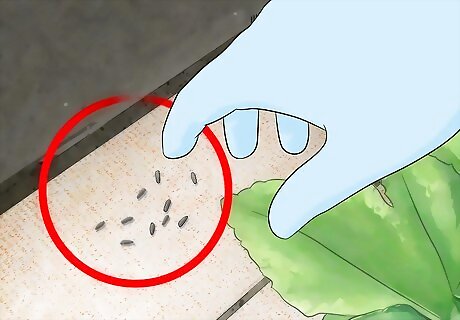
Clean the cage everyday. Caterpillars will be busy eating and growing and can make quite a mess in doing so. Because caterpillars can be so messy, you'll need to clean their cage everyday to help them stay healthy and have a good environment to grow up in. Always remember to remove any droppings or messes that your caterpillars make each day.
Watching the Metamorphosis
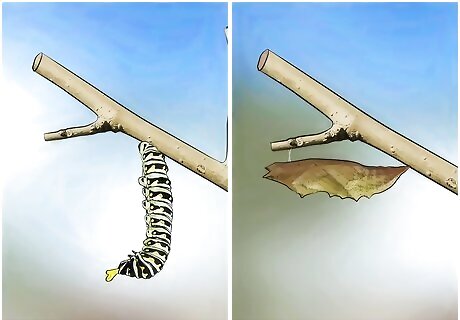
Provide a way for your caterpillar to pupate. At some point, your caterpillar will enter into the pupation stage of its life. It will spin a cocoon around itself and become inactive, slowly metamorphosing into a butterfly. If your caterpillar was a moth, it will likely need some dirt at the bottom of its cage to pupate inside of. It's best to provide for either type of caterpillar just in case. Some caterpillars will build their chrysalis and hang it from a leaf or a wall. You may need to move the chrysalis to another enclosure if the original is too small to accommodate the butterfly or moth when it hatches. Provide sturdy twigs or stems for caterpillars who like to hang their chrysalis. If you aren't sure what kind of caterpillar you have, adding a small layer of dirt for a moth to pupate in can be a good idea.
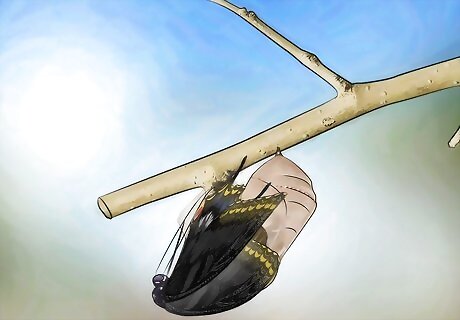
Wait for the pupa to hatch. After you've noticed your caterpillar enter the pupation phase of its life, all you need to do is wait. Your caterpillar will sit quietly inside of its cocoon as it changes into its butterfly form. Watch the pupa everyday for signs that it's getting ready to hatch so you can catch the moment it emerges. Some butterflies can hatch in only 8 days. Other butterflies may take months to hatch, spending the winter in their cocoon. You'll need to keep the chrysalis in an environment that has an ideal temperature and humidity for that species of moth or butterfly. You should lightly mist the chrysalis each day to provide moisture. The chrysalis will become transparent right before the butterfly is about to emerge.
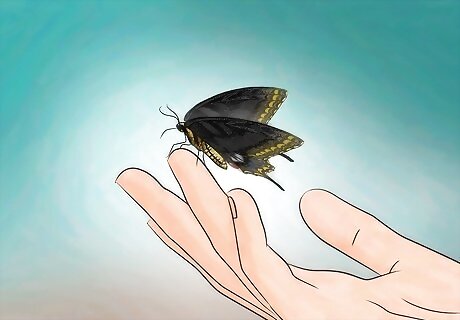
Enjoy and release the butterfly or moth that emerges. Take some time to enjoy the beautiful colors or patterns on your butterfly or moth after it emerges from the chrysalis. You'll still need to care for it a bit longer, waiting until it strengthens its wings and starts flying. Once you're sure the butterfly or moth is fully developed, it's time to say goodbye and let your friend go back into the wild. Release the butterfly or moth in the same area that you found it in originally. Make sure the butterfly has enough room in the cage to stretch its wings out. If the cage is too small, your butterfly or moth may develop deformed wings. Add some twigs to the cage for the butterfly to rest on and stretch its wings.




















Comments
0 comment